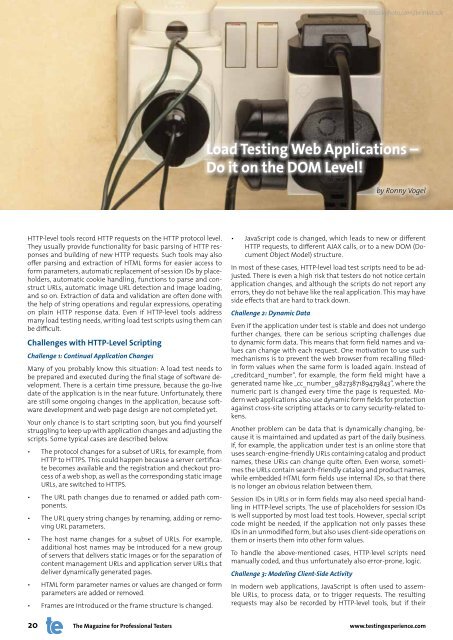Agile Performance Testing - Testing Experience
Agile Performance Testing - Testing Experience
Agile Performance Testing - Testing Experience
Create successful ePaper yourself
Turn your PDF publications into a flip-book with our unique Google optimized e-Paper software.
HTTP-level tools record HTTP requests on the HTTP protocol level.<br />
They usually provide functionality for basic parsing of HTTP responses<br />
and building of new HTTP requests. Such tools may also<br />
offer parsing and extraction of HTML forms for easier access to<br />
form parameters, automatic replacement of session IDs by placeholders,<br />
automatic cookie handling, functions to parse and construct<br />
URLs, automatic image URL detection and image loading,<br />
and so on. Extraction of data and validation are often done with<br />
the help of string operations and regular expressions, operating<br />
on plain HTTP response data. Even if HTTP-level tools address<br />
many load testing needs, writing load test scripts using them can<br />
be difficult.<br />
Challenges with HTTP-Level Scripting<br />
Challenge 1: Continual Application Changes<br />
Many of you probably know this situation: A load test needs to<br />
be prepared and executed during the final stage of software development.<br />
There is a certain time pressure, because the go-live<br />
date of the application is in the near future. Unfortunately, there<br />
are still some ongoing changes in the application, because software<br />
development and web page design are not completed yet.<br />
Your only chance is to start scripting soon, but you find yourself<br />
struggling to keep up with application changes and adjusting the<br />
scripts. Some typical cases are described below.<br />
• The protocol changes for a subset of URLs, for example, from<br />
HTTP to HTTPS. This could happen because a server certificate<br />
becomes available and the registration and checkout process<br />
of a web shop, as well as the corresponding static image<br />
URLs, are switched to HTTPS.<br />
• The URL path changes due to renamed or added path components.<br />
• The URL query string changes by renaming, adding or removing<br />
URL parameters.<br />
• The host name changes for a subset of URLs. For example,<br />
additional host names may be introduced for a new group<br />
of servers that delivers static images or for the separation of<br />
content management URLs and application server URLs that<br />
deliver dynamically generated pages.<br />
• HTML form parameter names or values are changed or form<br />
parameters are added or removed.<br />
• Frames are introduced or the frame structure is changed.<br />
© iStockphoto.com/brinkstock<br />
Load <strong>Testing</strong> Web Applications –<br />
Do it on the DOM Level!<br />
by Ronny Vogel<br />
• JavaScript code is changed, which leads to new or different<br />
HTTP requests, to different AJAX calls, or to a new DOM (Document<br />
Object Model) structure.<br />
In most of these cases, HTTP-level load test scripts need to be adjusted.<br />
There is even a high risk that testers do not notice certain<br />
application changes, and although the scripts do not report any<br />
errors, they do not behave like the real application. This may have<br />
side effects that are hard to track down.<br />
Challenge 2: Dynamic Data<br />
Even if the application under test is stable and does not undergo<br />
further changes, there can be serious scripting challenges due<br />
to dynamic form data. This means that form field names and values<br />
can change with each request. One motivation to use such<br />
mechanisms is to prevent the web browser from recalling filledin<br />
form values when the same form is loaded again. Instead of<br />
„creditcard_number“, for example, the form field might have a<br />
generated name like „cc_number_9827387189479843“, where the<br />
numeric part is changed every time the page is requested. Modern<br />
web applications also use dynamic form fields for protection<br />
against cross-site scripting attacks or to carry security-related tokens.<br />
Another problem can be data that is dynamically changing, because<br />
it is maintained and updated as part of the daily business.<br />
If, for example, the application under test is an online store that<br />
uses search-engine-friendly URLs containing catalog and product<br />
names, these URLs can change quite often. Even worse, sometimes<br />
the URLs contain search-friendly catalog and product names,<br />
while embedded HTML form fields use internal IDs, so that there<br />
is no longer an obvious relation between them.<br />
Session IDs in URLs or in form fields may also need special handling<br />
in HTTP-level scripts. The use of placeholders for session IDs<br />
is well supported by most load test tools. However, special script<br />
code might be needed, if the application not only passes these<br />
IDs in an unmodified form, but also uses client-side operations on<br />
them or inserts them into other form values.<br />
To handle the above-mentioned cases, HTTP-level scripts need<br />
manually coded, and thus unfortunately also error-prone, logic.<br />
Challenge 3: Modeling Client-Side Activity<br />
In modern web applications, JavaScript is often used to assemble<br />
URLs, to process data, or to trigger requests. The resulting<br />
requests may also be recorded by HTTP-level tools, but if their<br />
20 The Magazine for Professional Testers www.testingexperience.com









